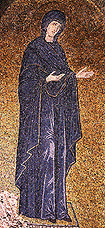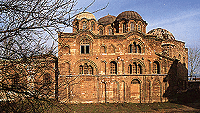 |
|
 |
Constantinople
 n the capital of the state of the Palaiologoi, the tendency to add side-chapels, porches and n the capital of the state of the Palaiologoi, the tendency to add side-chapels, porches and
 peristyles to earlier churches and
to decorate them with wall paintings, continued
after the recovery of the City by the Byzantines. One of the most important monuments of Constantinople is the monastery of the Virgin Pammakaristos (now known as the Fethiye Camii). The main church, which was built around 1100, was restored by
Michael Glabas Tarchaneiotes
possibly in 1260-5, that is immediately after the recapture of Constantinople. To the original building Tarchaneiotes added the northern domed annexe, which he had most probably intended as his burial place. Later, after his death in the first decade of the 14th century, his widow Mary, who became a nun under the name of Martha, added a chapel to the south side. The small building belonged to the type of
cross-in-square church with dome
and was decorated with particularly beautiful mosaics,
which compose an iconographic programme of eschatological content in keeping with the funerary character of the building. Thus, the Saints portrayed in the church, together with the Virgin and St. John the Baptist on either side of Christ, depicted enthroned in the centre of the apse, are
peristyles to earlier churches and
to decorate them with wall paintings, continued
after the recovery of the City by the Byzantines. One of the most important monuments of Constantinople is the monastery of the Virgin Pammakaristos (now known as the Fethiye Camii). The main church, which was built around 1100, was restored by
Michael Glabas Tarchaneiotes
possibly in 1260-5, that is immediately after the recapture of Constantinople. To the original building Tarchaneiotes added the northern domed annexe, which he had most probably intended as his burial place. Later, after his death in the first decade of the 14th century, his widow Mary, who became a nun under the name of Martha, added a chapel to the south side. The small building belonged to the type of
cross-in-square church with dome
and was decorated with particularly beautiful mosaics,
which compose an iconographic programme of eschatological content in keeping with the funerary character of the building. Thus, the Saints portrayed in the church, together with the Virgin and St. John the Baptist on either side of Christ, depicted enthroned in the centre of the apse, are
 shown in an attitude of prayer, mediating for the salvation of humankind. This mosaic ensemble is dated to between 1310 and 1315 and from the stylistic point of view, as H. Belting says, the figures are characterised by a restrained classicism and a tendency to return to middle Byzantine models. The most important monument in Constantinople, however, is the katholikon of the Chora monastery, which was repaired at that time and adorned with mosaics and wall paintings. The high patronage of the monument is reflected in the superb quality of the katholikon, which is why we shall examine it presently in greater detail.
shown in an attitude of prayer, mediating for the salvation of humankind. This mosaic ensemble is dated to between 1310 and 1315 and from the stylistic point of view, as H. Belting says, the figures are characterised by a restrained classicism and a tendency to return to middle Byzantine models. The most important monument in Constantinople, however, is the katholikon of the Chora monastery, which was repaired at that time and adorned with mosaics and wall paintings. The high patronage of the monument is reflected in the superb quality of the katholikon, which is why we shall examine it presently in greater detail.
|

